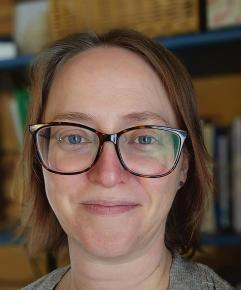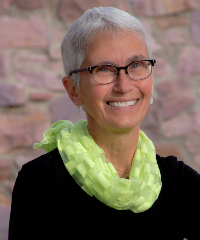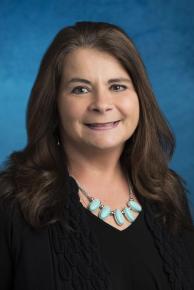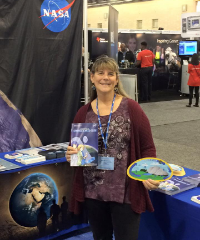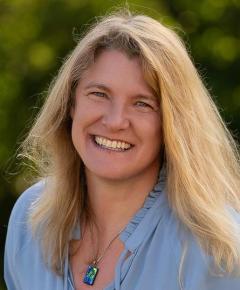Community Blogs
Community Blogs
Discover how the GLOBE community is engaging in all things GLOBE through the community blog posts below.
Learn how to create a GLOBE community blog post.
Filter By:
Blogs List
Audience
Middle and high school students
Time
At least 2 classroom periods, depending on data collection
Day 1 : Read “Full Throttle Model”
Day 2 : Site visit and protocols
Materials
Full
Throttle Model (pdf)
GLOBE Protocols:
Water Transparency
Land
Cover Classification
Alternative: Use the GLOBE Observer app Land
Cover tool
GLOBE learning ...
Read More »
Posted in:
Investigation Areas:
WATER TRANSPARENCY
LAND COVER CLASSIFICATION
Discover the Wonders of the World’s Forests!
Greetings, middle and high school educators! Are you ready to bring
the wonders of forests into your classroom? Dive into this blog series
that bridges the resources of Natural Inquirer and the GLOBE Program,
designed to inspire curiosity, scientific exploration, and
environmental stewardship among your students.
GLOBE and Natural Inquirer Crosswalk
This series is part of the
GLOBE
and Natural Inquirer Crosswalk Project , which connects the
hands-on science of the GLOBE Program with the captivating research
found ...
Posted in:
Curriculum:
SCIENCE AND MATH
GLOBE Science Topics:
CLIMATE
CLIMATE CHANGE
EARTH AS A SYSTEM
Investigation Areas:
EARTH AS A SYSTEM
PRECIPITATION
AIR TEMPERATURE
SURFACE TEMPERATURE
BIOMETRY (INCLUDING TREE HEIGHT)
LAND COVER CLASSIFICATION
CARBON CYCLE
Primary Audience:
TEACHERS
Teacher's Guide:
MIDDLE: 6-8
SECONDARY: 9-12
Audience
Middle school and high school
Time
Approximately 2 class periods: one for reading the Natural Inquirer
inquiry and reviewing images and charts, and one for using the GLOBE resources.
Day 1 : Dive into The World’s Forests 2 inquiry, exploring
images and data.
Day 2 : Apply your learning with GLOBE resources for hands-on discovery.
Materials
The
World’s Forests 2 (pdf), Inquiry 1
Earth
System Poster learning activities (pdf)
Analyzing
Global Patterns with the Earth System Satellite Images (see ...
Posted in:
Curriculum:
SCIENCE AND MATH
GLOBE Science Topics:
CLIMATE
GLOBE PROTOCOLS
EARTH AS A SYSTEM
Investigation Areas:
PRECIPITATION
BIOMETRY (INCLUDING TREE HEIGHT)
LAND COVER CLASSIFICATION
Primary Audience:
TEACHERS
Teacher's Guide:
MIDDLE: 6-8
SECONDARY: 9-12
Our project for SEES 2024 was "Creating a Model to Identify
High-Risk Areas for Flash Flooding in Houston, Texas." In this
blog, I will discuss how we calculated which areas are "high-risk."
There are many ways to identify the most at-risk points of flooding
in a given region. Such points are commonly identified in a flood map,
such as the one here:
For our project, we decided to look at elevation data, which is
perhaps the most intuitive: water flows downhill and will accumulate
in the lowest regions. To get our elevation data, we used ...
Posted in:
GLOBE Science Topics:
CLIMATE CHANGE
EARTH AS A SYSTEM
EARTH SYSTEM SCIENCE
Investigation Areas:
EARTH AS A SYSTEM
BIOSPHERE
LAND COVER CLASSIFICATION
Primary Audience:
SCIENTISTS
STUDENTS
TEACHERS
Student Research Reports:
MISSION MOSQUITO REPORT
SEES 2024 Experience
Getting the opportunity to participate in the NASA SEES Earth System
Explorers program has positively impacted my educational and career
journey in more ways than I could've imagined. Throughout this
internship, I gained an immense amount of knowledge in Earth science,
utilizing the GLOBE Observer app, ArcGIS, Collect Earth Online,
Python, and many other tools to better understand the environment
around us. During the last few weeks of the program, a team of seven
other interns and I completed our own research project called
"Harnessing ...
Posted in:
GLOBE Science Topics:
EARTH AS A SYSTEM
Investigation Areas:
EARTH AS A SYSTEM
LAND COVER CLASSIFICATION
MOSQUITOES
Primary Audience:
SCIENTISTS
STUDENTS
TEACHERS
Student Research Reports:
MISSION MOSQUITO REPORT
In this blog post, I will go through every step of the internship and
outline my experience!
Before I do that, first of all, I would like to say that I am so
happy that I got to spend my summer with SEES! This program was so
amazing and helped guide me a bit more on what I want to do in my
future career and in college! I am very grateful for all of our
mentors who guided us through the program and provided great knowledge
and support to all of us! Thank you for this opportunity.
Modules: Climate Science Background and Exploring the Earth
To prepare for the ...
Posted in:
GLOBE Science Topics:
EARTH AS A SYSTEM
Investigation Areas:
EARTH AS A SYSTEM
LAND COVER CLASSIFICATION
MOSQUITOES
Student Research Reports:
MISSION MOSQUITO REPORT
The wildfire data analysis journey began with a dataset comprising
over 1200 points located in the California region. To uncover the
correlation between land cover types and wildfire risk, we first
needed to determine the wildfire risk for each point using the FEMA
Wildfire Risk Map. This step involved entering coordinates into the
software to obtain the wildfire risk index for each location. From
this dataset, we categorized approximately 325 points as having a very
low risk, 350 as moderate risk, and 578 as very high risk for
wildfires. These categories served as the ...
Posted in:
GLOBE Science Topics:
EARTH AS A SYSTEM
Investigation Areas:
EARTH AS A SYSTEM
LAND COVER CLASSIFICATION
Primary Audience:
SCIENTISTS
STUDENTS
TEACHERS
Student Research Reports:
MISSION MOSQUITO REPORT
Roboflow is an open-source dataset management platform, where users
can import data, label it, and then have a model train on it. For my
group's project, CS-FLARE, we used Roboflow to label brush, grass,
trees, and leaf litter in our NESW Images as shown below.
When I initially began labeling images, I tried
using bounding boxes for each picture like the leaf litter in the
image above. This became a bit annoying as sometimes the bounding
boxes would cut parts of objects like trees, but it was still faster
than using the polygon tool to manually trace around objects. ...
Posted in:
Investigation Areas:
EARTH AS A SYSTEM
LAND COVER CLASSIFICATION
MOSQUITOES
Primary Audience:
STUDENTS
TEACHERS
Student Research Reports:
MISSION MOSQUITO REPORT
Adopt-a-Pixel | Where does water meet land in my community?
Scanning the Area
As our first assignment as part of the Earth System Explorers team, we've been tasked with making our first observations using the GLOBE Observer App. The goal was to make 12 total observations (6 Potential Mosquito Habitat & 6 Land Cover).
To be more efficient, I decided to make all of my observations at 6 different still bodies of water. This way I could do a MHM and a LC observation at each location.
Before I began, I scouted potential bodies of water on Global Surface Water ...
Posted in:
Investigation Areas:
EARTH AS A SYSTEM
LAND COVER CLASSIFICATION
MOSQUITOES
Primary Audience:
STUDENTS
TEACHERS
TRAINERS
I built my mosquito traps on June 20th and ran the experiment until July 15th. I collected a total of 15 observations during this period. To construct the traps I used three identical pots to hold water. The goal of my experiment was to find which type of mosquito bait would be the most effective at attracting and sheltering mosquitos. For the three baits I used dried leaves, grass clippings, and a wooden plank. I chose these three baits because they represent possible real life environments that mosquitos may breed in. The dried leaves simulates a pool of water that does not evaporate ...
Posted in:
Investigation Areas:
HYDROSPHERE
EARTH AS A SYSTEM
LAND COVER CLASSIFICATION
MOSQUITOES
Primary Audience:
STUDENTS
TEACHERS
TRAINERS
My mosquito trap was definitely a rollercoaster, and with this being the last required update, I still plan on seeing how the traps do after the internship finishes since this has been really interesting. To give some background, I set out three traps around 30-40 yards away from each other around my AOI so I could get an idea of how different areas may yield different results. The first trap was in my backyard, the second trap was in a park close to my house, and the third was by a sidewalk (the pictures I use are from the third trap). The only trap I really had to refill with water was ...
Posted in:
GLOBE Science Topics:
EARTH AS A SYSTEM
Investigation Areas:
LAND COVER CLASSIFICATION
MOSQUITOES
Primary Audience:
STUDENTS
TEACHERS
TRAINERS
Student Research Reports:
INTERNATIONAL VIRTUAL SCIENCE SYMPOSIUM REPORT
MISSION MOSQUITO REPORT
Mosquito Trap
Week 1
For the mosquito traps, I decided quite early on that my independent variable would be the container. I got 3 different containers; an old tire, a black bucket, and a gallon bottle/container while keeping all other factors the same. I used the same bait and the same amount of water and placed all 3 traps in my backyard behind the shade of the t ree. I decided on using a timeframe of about 5 days to take my samples.
Week 1:
Five days had passed, and it was time to sample the traps. Unfortunately, when I got ...
Posted in:
Investigation Areas:
BIOSPHERE
LAND COVER CLASSIFICATION
MOSQUITOES
Primary Audience:
STUDENTS
TEACHERS
TRAINERS
Student Research Reports:
INTERNATIONAL VIRTUAL SCIENCE SYMPOSIUM REPORT
MISSION MOSQUITO REPORT
AOI Fieldwork
At first, collecting land cover data for 37 points within my area of interest felt like a daunting task. However, after only a few "expeditions" in the past week, I was able to complete all 37 observations.
To make my work easier and more accurate, I intentionally choose an AOI that would contain as many points as possible within a nearby park. This was to ensure that I could access as many points as possible. Despite my best efforts, many of the points still landed in residential properties. This activity actually reminded me how many neighborhoods there are in my ...
Posted in:
Investigation Areas:
HYDROSPHERE
EARTH AS A SYSTEM
LAND COVER CLASSIFICATION
MOSQUITOES
Primary Audience:
STUDENTS
TEACHERS
TRAINERS
Student Research Reports:
INTERNATIONAL VIRTUAL SCIENCE SYMPOSIUM REPORT
MISSION MOSQUITO REPORT
GLOBE Goes to Camp is in full swing for the summer with GLOBE data collection and informal learning opportunities for campers across the United States. Campers participated in hydrology, soil, land cover, and tree investigations throughout the month of June looking for freshwater macro-invertebrates all the way to who could find the tallest tree. Campers are engaging not only in STEAM based learning opportunities, but are also building a sense of environmental stewardship as they learn about how what we do affects the Earth as a system. Communities are becoming involved as they learn ...
Posted in:
Curriculum:
LANGUAGE CULTURE AND ARTS
SCIENCE AND MATH
STEM
Investigation Areas:
HYDROSPHERE
LAND COVER CLASSIFICATION
In October, our SEES research team presented at the 2022 MIT Undergraduate Research Technology Conference (MIT URTC), becoming the first SEES team ever to be selected to present a paper at this competition. We wanted to share our experience with MIT URTC, from the starting point of our SEES research project to developing a publishable manuscript and presenting our paper at the conference.
At the onset of our research, we were motivated by a story we read in the news that detailed how human populations worldwide were becoming increasingly susceptible to vector-borne diseases, with ...
Posted in:
GLOBE Science Topics:
EARTH AS A SYSTEM
EARTH SYSTEM SCIENCE
Investigation Areas:
EARTH AS A SYSTEM
LAND COVER CLASSIFICATION
MOSQUITOES
News Topics:
NEWS BRIEFS
Primary Audience:
PARTNERS
SCIENTISTS
STUDENTS
TEACHERS
Student Research Reports:
INTERNATIONAL VIRTUAL SCIENCE SYMPOSIUM REPORT
MISSION MOSQUITO REPORT
Background
Remote working and remote learning presented challenges to
us all. As a Master Trainer in Colombia, Juan Felipe Restrepo Mesa
faced and overcame his share of challenges when working with a new
group of educators from rural areas. Most of the training material
and the tests that need to be answered were in English. This, of
course, means that citizen scientists who do not speak English were
prevented from making their contributions living in those areas where
GLOBE Observer Mosquito Habitat Mapper's contributions are essential.
Juan Felipe had to set up a MEET ...
Posted in:
GLOBE Science Topics:
EARTH AS A SYSTEM
EARTH SYSTEM SCIENCE
Investigation Areas:
HYDROSPHERE
LAND COVER CLASSIFICATION
MOSQUITOES
Primary Audience:
COUNTRY COORDINATORS
PARTNERS
SCIENTISTS
TEACHERS
TRAINERS
The newest satellite to monitor global sea level is ready for its journey into space. Sentinel-6 Michael Freilich, the latest in a series of spacecraft designed to monitor the global ocean, is scheduled to launch on Saturday, Nov. 21. Will you be watching?
Sentinel-6 Michael Freilich , the latest in a series of spacecraft designed to monitor our oceans, is scheduled to launch from Vandenberg Air Force Base in central California on Saturday, Nov. 21, 2020. The satellite will be followed in 2025 by its twin, Sentinel-6B. Together, the pair is tasked with extending our nearly ...
Posted in:
Curriculum:
EDUCATION RESEARCH
SCIENCE AND MATH
TECHNOLOGY
STEM
Field Campaigns:
SEASONS AND BIOMES
WATERSHEDS
EL NIÑO
GPM
GLOBE Science Topics:
CLIMATE
CLIMATE CHANGE
DATA INCLUDED
GENERAL SCIENCE
EARTH AS A SYSTEM
EARTH SYSTEM SCIENCE
SCIENTIST SKILLS
GLOBE Working Groups:
SCIENCE WORKING GROUP
EDUCATION WORKING GROUP
TECHNOLOGY WORKING GROUP
Investigation Areas:
ATMOSPHERE
WATER VAPOR
EARTH AS A SYSTEM
PRECIPITATION
WATER TEMPERATURE
GREEN-UP / GREEN-DOWN
LAND COVER CLASSIFICATION
Learning Activities:
S2: WHAT ARE SOME FACTORS THAT AFFECT SEASONAL PATTERNS?
S4: MODELING THE REASONS FOR SEASONAL CHANGE
S5: SEASONAL CHANGE ON LAND AND WATER
LC2: REPRESENTING THE STUDY SITE IN A DIAGRAM
LC3: USING GRAPHS TO SHOW CONNECTIONS
WE'RE ALL CONNECTED: EARTH SYSTEM INTERACTIONS
S3: HOW DO SEASONAL TEMP PATTERNS VARY AMONG DIFFERENT WORLD REGIONS?
WATER WALK
MODEL A CATCHMENT BASIN
PRACTICING YOUR PROTOCOLS
WATER DETECTIVES
MODEL YOUR WATER BALANCE
MEASURE UP
WATER WONDERS
Primary Audience:
ALUMNI
COUNTRY COORDINATORS
PARTNERS
SCIENTISTS
STUDENTS
TEACHERS
TRAINERS
Student Research Reports:
STANDARD RESEARCH REPORT
U.S. STUDENT RESEARCH SYMPOSIA (SRS)
MISSION EARTH REPORT
MISSION MOSQUITO REPORT
The ICESat-2 Satellite will launch from Vandenberg Air Force Base in Lompoc, California on Saturday, September 15, 2016. At this time, the Trees Around the GLOBE Student Research Campaign will officially begin.
If you happen to find yourself in Lompoc, California for the launch, please take a look at this Explore Lompoc web site. It provides some great information about all the ICESat-2 launch activities that will be happening. We also have an ICESat-2 Launch Outreach page that showcases launch information and a launch party kit.
The launch of the ICESat-2 satellite will ...
Posted in:
Investigation Areas:
PRECIPITATION
CARBON CYCLE
AIR TEMPERATURE
SURFACE TEMPERATURE
SOIL TEMPERATURE
BIOSPHERE
BIOMETRY (INCLUDING TREE HEIGHT)
LAND COVER CLASSIFICATION
GREEN-UP / GREEN-DOWN
I've been digging through my Inbox, trying to clear out some of the large files from the past. I'm at a critical point as these files are triggering invitations to buy more space for storage. Rather than doing that, I'm deleting instead!
But during this process, I've come across some resources and discussions that I always seem to forget exist already on the GLOBE website. I thought that perhaps I'd write a couple blog posts and point out some of these for anyone following my blog.
This first one is a training agenda from 2003! A group of us were invited to Washington, D.C. to work ...
Posted in:
Curriculum:
SCIENCE AND MATH
GLOBE Science Topics:
GENERAL SCIENCE
GLOBE PROTOCOLS
SCIENTIST SKILLS
Investigation Areas:
BIOMETRY (INCLUDING TREE HEIGHT)
BIOSPHERE
LAND COVER CLASSIFICATION






